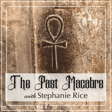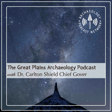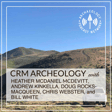Become a Creator today!Start creating today - Share your story with the world!
Start for free
00:00:00
00:00:01

Tombs from the Dawn of Egypt pt 2 - Ep 02
Continue the journey through the ancient tomb architecture of Early Dynastic Egypt that paved the way for the pyramids. Uncover recently discovered predynastic tombs in the Nile Delta and explore Saqqara’s grand necropolis. From the tombs of elite Egyptians to the monuments of Merneith, the first woman to rule Egypt, and the Step Pyramid of Djoser, we’ll reveal the powerful afterlife rituals and artistic traditions that shaped Egypt's iconic burial monuments.
Links
- See photos related to episode topics on Instagram
- Loving the macabre lore? Treat your host to a coffee!
- Head over to the show notes page to see photos!
Affiliates
Transcript
Introduction
00:00:01
Speaker
You're listening to the Archaeology Podcast Network.
Reevaluating Tel El Fercha's Archaeological Significance
00:00:27
Speaker
Far to the north of Necken and Abidos, in the fertile wetlands of the Nile Delta, lies a place that, at first glance, seems unremarkable. The locals call it Tel El Fercha, or Chicken Hill, and it's a small trio of unassuming rises amidst the agricultural fields. It's about 120 kilometers, or 70 miles roughly, northwest of Cairo.
00:00:55
Speaker
In 1987, archaeologists first took note of this location. But after a few years of excavation, they abandoned it by 1990, believing that there was little of significance buried here.
00:01:08
Speaker
But in 1998, a team of researchers returned, suspecting that these hills weren't entirely natural. They proved to be correct, and there were indeed buildings here. What they uncovered continues to provide new information that changes our understanding of the pre-dynastic period in Lower Egypt, as well as the unification of the two lands that became Egypt as we know it.
00:01:35
Speaker
Through the remains of buildings and art and everyday goods, archaeologists have found evidence of Upper Egyptians moving north, slowly integrating into this region, a peaceful coexistence instead of violent conquest. This was in sharp contrast to the older theories based on the art depicting the kings of the pre-Dynastic and early-Dynastic periods.
Architectural Discoveries at Tel El Farqah
00:02:01
Speaker
One of the most incredible discoveries at Tel El Farqah was uncovered in 2006. It's the largest pre-dynastic tomb found so far in Egypt. And astonishingly, it's also the oldest mastaba. The word mastaba comes from the Arabic word for bench. It was describing the shape of these structures.
00:02:27
Speaker
But to the ancient Egyptians, these tombs were called perjet, meaning house of stability or house of eternity. And they were built to last for eternity, to guard the body of the deceased forever.
00:02:41
Speaker
Unlike the wooden structures used for the elite burials at Neckin, these mastabas were constructed with thick mud bricks, signaling the permanence and protection they offered. Most likely their occupants learned from their predecessors and the fires that took out the above ground structures that marked their burial grounds. This particular mastaba sprawls across nearly 300 square meters, with walls over 2.5 meters thick.
00:03:11
Speaker
These walls slope inward as they rise, giving that slight bench-like feature.
Mysteries of the Large Tomb at Tel El Farqah
00:03:19
Speaker
And this would become a standard in the mastaba architecture.
00:03:24
Speaker
Along its exterior, niches were carefully placed into the walls with the brick architecture. These niches became what's known as the palace facade, which were meant to mimic the royal palaces and symbolize the eternal connection between the deceased and their divine kingship. This grand structure would have made for an impressive sight rising out of the Nile Delta over 5,000 years ago.
00:03:53
Speaker
Who could have been laid to rest here? Could it be the tomb of the last ruler of the delta before Narmer united Egypt? Clearly they were someone of importance based on the size and effort that would have been placed into building this tomb.
00:04:08
Speaker
The mystery remains unsolved. Excavations continue here, but only fragments of pottery and flint tools have been uncovered so far. None of them bear the name or any sort of insignia to show us who was buried here.
Advancements in Tomb Architecture at Saqqara
00:04:25
Speaker
Now, let's journey southwest to the Necropolis of Saqqara, about 30 kilometers or roughly 18 and a half miles outside of Cairo today.
00:04:37
Speaker
Sakhara is named after the falcon-headed god of the dead, Sekhar, or Sokhar, who was worshipped here in Lower Egypt. It served as the main burial ground for the early capital of the unified Egypt. This was called Men Nefer, or Memphis, as we know it today.
00:04:58
Speaker
During the first dynasty, Saqqara was home to some of the grandest tombs of the time. They were built to be seen from the Nile, standing as monuments to royal wives, non-royal elites, and eventually kings as well.
The Legacy of Egypt's First Female Ruler, Merneath
00:05:14
Speaker
The mastabahs here at Saqqara were previously the oldest in Egypt until the find at Tell el-Fahr.
00:05:22
Speaker
These are still impressive in their own right, and they show a new step in mastaba architecture that improves upon those that were found at Tel El Tharcha. One of the most famous tombs here likely belonged to Mernath, the first woman to rule Egypt in her own right. Grave goods that were found here in the tomb were inscribed with her name and the royal falcon of Horus. This is what led archaeologists to believe that this mastaba belonged to her.
00:05:52
Speaker
Mernaeth was the fifth ruler in Egypt's first dynasty. She followed her father Jett and ruled for years until her son Din was old enough to take the throne. Her mastaba was nearly 700 square meters, or about 2700 square feet.
00:06:12
Speaker
an architectural marvel in its time. The mudbrick walls had the palace facade and they were covered in plaster then painted with vivid reds, greens, blacks, and yellows like the painted tomb at Neckin. All around its base, a pavement of packed silk and mud was plastered as well and then painted in striking shades of blue and red.
00:06:38
Speaker
As with many royal tombs of the first dynasty at Abidos, subsidiary graves surrounded Mernath's mastaba, showing signs of retainer sacrifice. This was a practice where servants were buried with their rulers and were killed sometime near the ruler's death to serve them in the afterlife.
00:07:02
Speaker
among these graves was that of the artist who helped craft and paint this grand monument. Paint pots were found within his tomb, some still containing traces of the paint that were used to decorate Marinath's walls. What was unique about Marinath's funerary complex here is that she was the first ruler to have the members of her court buried here at Saqqara.
00:07:28
Speaker
inside of Merenath's tomb were an additional 21 storerooms that were filled with provisions for her journey into the afterlife. Her burial chamber beneath the mastaba was about 17 square meters or 55 square feet, roughly. Unfortunately, a fire so intense that it shattered stone vessels destroyed most of the grave goods.
00:07:54
Speaker
Only tiny fragments of bone and traces of gold leaf remained among the ashes of where a wooden coffin once stood. This indicates that Mernath may have also been the first royal buried here at Saqqara instead of Abidos. This was no ordinary fire. It burned quickly, suggesting the flames were set intentionally and the archaeological evidence indicates that this happened soon after her funeral.
00:08:24
Speaker
Was this an attempt to erase her memory? A deliberate act of damnatio memore, which is the ancient practice of erasing someone from history. It's hard to say for certain, but the evidence points in that direction. And eerily, something very similar happened at Merenath's other tomb in Abydos. In Abydos, her cenotaph was located near the tomb of her father, Jett.
00:08:52
Speaker
It was a large multi-chambered structure with mud brick walls. Even though she wasn't buried here, her burial monument is still surrounded by 41 subsidiary graves, again with signs of retainer sacrifice. Mernaeth was the first ruler to have subsidiary burials at both of her tombs. Did she do this as a display of power?
00:09:18
Speaker
Unfortunately, any additional information that could help us answer that question has burned to ashes. Just like in Saqqara, the central burial chamber was burned, leaving little behind. Except, luckily, there were two stone stela. Stela are the large stone markers for tombs used in ancient Egypt. And these stela were inscribed with Mernath's name.
00:09:46
Speaker
One of these stele was found in near perfect condition by the initial archaeology team who found it and excavated the tomb. It's now preserved at the Egyptian Museum in Cairo, and it's a rare and powerful reminder of Egypt's first female ruler.
Evolution from Mud Brick to Rock-Cut Tombs
00:10:04
Speaker
I will include pictures of it in social media posts and hopefully the show notes as well, because I can remember standing in front of it. This stone that preserved the name of a queen whose memory someone tried so hard to erase. And yet here she is still remembered nearly 5,000 years later.
00:10:27
Speaker
As we continue our journey through the Necropolis of Saqqara, let's shift our focus to the tombs built nearby Mernath's. These tombs were built after her reign and they show us the next stages in the evolution of ancient Egyptian funerary architecture. Among these is tomb 3507, which dates back to the reign of Din, who was Mernath's son and ruled around 2940 BCE.
00:10:57
Speaker
This tomb doesn't hold a ruler though, but instead it's the eternal resting place for one of the elite residents of the capital of Egypt, Men Nefer, or Memphis.
00:11:09
Speaker
Din ruled during a prosperous time of growth, as many of the first dynasty rulers did. We can see this reflected in the fact that non-royal tombs were able to experiment, so to speak, and build upon the advancements in the way that tombs were constructed with grand monuments of their own fit for royals. Tomb 3507 stands out for its fusion of older architectural traditions into new design features.
00:11:38
Speaker
It combines two elements previously seen in earlier Saqqara tombs, the burial mound and a bench-like ledge adorned with clay bullheads. The burial mound sat above the burial chamber inside of the mastaba instead of the burial mound resting on its own above the tomb. The mastaba itself still had the niched palace facade architecture for its exterior walls that had become consistent with all mastaba of the period.
00:12:09
Speaker
Archaeological evidence suggests that the burial mounds represented something deeply symbolic. The Primordial Hill, or Ben Benstone, according to some of the ancient Egyptian creation myths, was the first mound of earth that emerged from the Primordial waters at the beginning of everything.
00:12:30
Speaker
This symbolic link to creation and rebirth within the architecture for the dead would be echoed later in the Pyramid Capstone, known as the Bin Binet or Pyramidion, found on Egypt's Grand Pyramids later. The ledge adorned with clay bullheads was a low platform that stood at roughly bench height.
00:12:54
Speaker
The clay bullheads rose up from the ledges and each had real bull horns set into them. This design harkens back to traditions from both upper and lower Egypt, and these elements symbolized strength, fertility, and power.
00:13:13
Speaker
Later in Egypt's history, these clay bullheads merged with other beliefs into a symbolic connection between the deceased and Osiris, further reinforcing ideas of eternal kingship and strength.
Second Dynasty Tombs and the Festival of Socar
00:13:29
Speaker
Several other nearby tombs of the elite buried here at Saqqara through the end of the First Dynasty showed different combinations of these and other previously seen architectural styles.
00:13:43
Speaker
As we get to the tombs from the start of Egypt's second dynasty, we begin to see major shifts in tomb construction at Saqqara. The early tombs relied heavily on mud brick for their structures, even the subterranean portions, but newer tombs adopted rock-cut chambers, carving them into the bedrock. This technique would evolve in later dynastic periods, but here we witness the beginning of it.
00:14:12
Speaker
An example of this innovation can be seen at tombs south of the Unas Causeway. Unas was a later king who built his pyramid complex atop several second dynasty tombs, destroying most of them unfortunately. From what's left, we can see that these tombs feature rock cut burial chambers and stairways with the interior rooms still partitioned using mud brick.
00:14:39
Speaker
Another fascinating feature that begins to appear in the tombs of this period is the depiction of the festival of Socar. This festival celebrated death and rebirth, much like the Osirian festivals at Abidos.
00:14:53
Speaker
The festival of Socar
Emergence of House-Type Tombs
00:14:55
Speaker
was held at the beginning of the planting season as well, around November. Archaeological evidence shows that the tombs at Socaro were visited during these festivals, with offerings left behind to honor the dead and ensure their continued journey into the afterlife.
00:15:13
Speaker
During the middle of the Second Dynasty, there was a shift toward what's known as the house-type tomb design. This is where chambers were cut separately into the rock, possibly mirroring the layout of contemporary homes.
00:15:29
Speaker
Tomb 2302, as archaeologists have called it, was built during the reign of King Ninet Gere in the Second Dynasty. This is an excellent example of this house-like architecture.
00:15:45
Speaker
Located in the northern cemetery of Sakara, this massive tomb spans over 58 meters in length and 32 meters in width, making it nearly 1,900 square meters or 20,000 square feet. With a substructure containing at least 26 rooms, this was massive.
00:16:08
Speaker
To no surprise, tomb 2302 is one of the largest out of all of the elite tombs at Saqqara. One Egyptologist even referred to it as one of the most powerful private tombs of the early Second Dynasty.
00:16:26
Speaker
This tomb belonged to an individual named Ruabin, whose name was inscribed on the stone vessels found within the burial. Ruabin held the title Overseer of Sculptors, clearly a prestigious position at the time.
00:16:43
Speaker
His tomb was so detailed in its homelike layout, it even contained a bathroom or washroom. Yes, and that is one of the more curious aspects of the tomb architecture from this era. This washroom was found at the far eastern end of the tomb, and it actually had a toilet with a stone seat on it.
00:17:06
Speaker
Similar washrooms have been found in other Second Dynasty tombs nearby, showing this continued trend of building a truly functional house of eternity.
Djoser's Step Pyramid: A Monumental Feat
00:17:19
Speaker
But the crowning jewel of Saqqara's early necropolis is undoubtedly the steppe pyramid of Djoser, still rising as an imposing feature in the desert above all of the monuments around it.
00:17:33
Speaker
Josur, the first king of the third dynasty, reigned in the 27th century BCE. As the founder of the new dynasty, he displayed his power and prosperity by having a tomb built that was unlike anything that came before it.
00:17:52
Speaker
The Step Pyramid is a testament to Egypt's architectural ingenuity. It was designed by the legendary Imhotep, who later became deified and worshipped as a god of healing and science, and was associated with the god Ta, sometimes even referred to as the son of Ta.
00:18:12
Speaker
The steppe pyramid began as a simple mastaba, but it was gradually expanded on within the lifetime of Djoser to become the towering six-steppe structure that we see today, standing at nearly 200 feet. Originally, its outer surface was encased in gleaming white limestone, making it one of the earliest large-scale cut stone structures in history.
00:18:40
Speaker
Imhotep's design was groundbreaking not only for its size, but for the symbolic meaning it carried. The step design likely was intended to symbolically shape it like the Benben stone in order to connect Jozer with the gods and creation.
00:19:00
Speaker
The entire step pyramid complex is extraordinary in its scope, surrounded by a massive stone wall and a rectangular dry moat.
00:19:12
Speaker
Some archaeologists believe this may have served as a quarry for the limestone that was used during the construction of the pyramid, or that it was possibly a water channel built to connect this site to the Nile and transport heavy building materials using barges. Another feature worthy of note is in the southern court of the pyramid complex. Archaeologists discovered an ox head carefully buried beneath an altar here.
00:19:41
Speaker
This is similar to the sacred burials of animals found in other funerary complexes across Egypt, just like the elephant and bull buried at Neckin that we learned about in the previous episode. The steppe pyramid of Djoser is the impressive culmination of centuries of tradition and technique.
Conclusion: Architectural Evolution and Historical Significance
00:20:02
Speaker
It was first built to be a mastaba larger than any that came before it to display the new king's power but then it gradually grew through ingenuity, trial, and error to become the first of the pyramids in Egypt.
00:20:20
Speaker
Thank you for joining me on this journey through the tombs at Tel El Fercha and Saqqara. If you missed it, be sure to check out the previous episode for a dive into the pre-dynastic tombs that inspired the tombs we explored in this episode. From the discovery of the oldest mastaba at Tel El Fercha, to the grand necropolis of Saqqara that reveals the monumental power and legacy of the rulers like Mernaeth and Josur.
00:20:49
Speaker
In this episode, we've uncovered tombs that not only reflect Egypt's evolving architecture, but also its one held in life.
Credits and Contact Information
00:21:07
Speaker
In the next episode, we'll finish our tour of the tombs of ancient
00:21:34
Speaker
This episode was produced by Chris Webster from his ah RV traveling the United States, Tristan Boyle in Scotland, DigTech LLC, Cultural Media, and the Archaeology Podcast Network, and was edited by Rachel Rodin. This has been a presentation of the Archaeology Podcast Network. Visit us on the web for show notes and other podcasts at www.archpodnet.com. Contact us at chris at archaeologypodcastnetwork dot.com.





